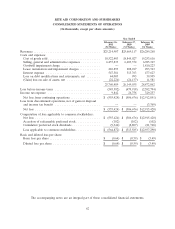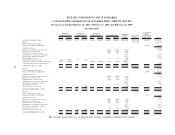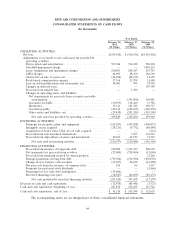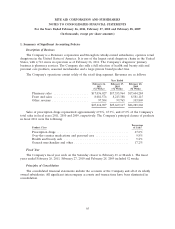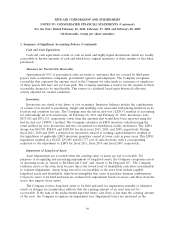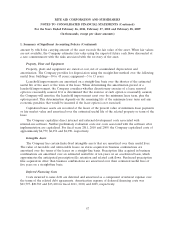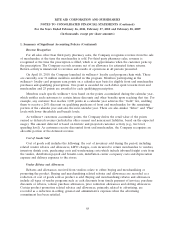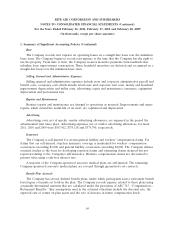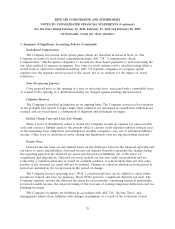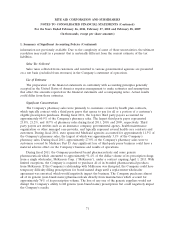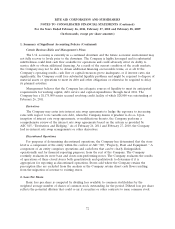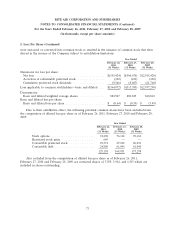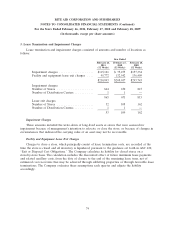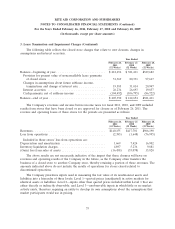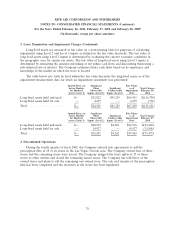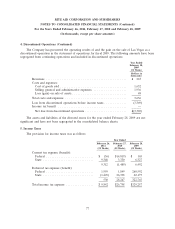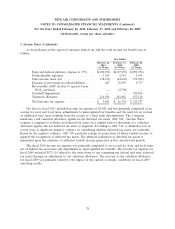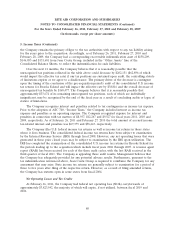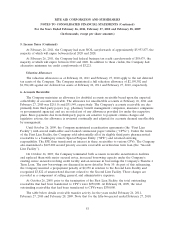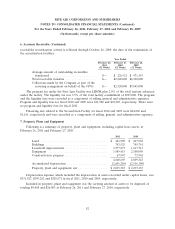Rite Aid 2011 Annual Report Download - page 72
Download and view the complete annual report
Please find page 72 of the 2011 Rite Aid annual report below. You can navigate through the pages in the report by either clicking on the pages listed below, or by using the keyword search tool below to find specific information within the annual report.RITE AID CORPORATION AND SUBSIDIARIES
NOTES TO CONSOLIDATED FINANCIAL STATEMENTS (Continued)
For the Years Ended February 26, 2011, February 27, 2010 and February 28, 2009
(In thousands, except per share amounts)
1. Summary of Significant Accounting Policies (Continued)
Certain Business Risks and Management’s Plans
The U.S. economy is currently in a continued downturn and the future economic environment may
not fully recover to levels prior to the downturn. The Company is highly leveraged and its substantial
indebtedness could limit cash flow available for operations and could adversely affect its ability to
service debt or obtain additional financing. As a result of the current condition of the credit markets,
the Company may not be able to obtain additional financing on favorable terms, or at all. If the
Company’s operating results, cash flow or capital resources prove inadequate, or if interest rates rise
significantly, the Company could face substantial liquidity problems and might be required to dispose of
material assets or operations to meet its debt and other obligations or otherwise be required to delay
its planned activities.
Management believes that the Company has adequate sources of liquidity to meet its anticipated
requirements for working capital, debt service and capital expenditures through fiscal 2012. The
Company has a $1,175,000 senior secured revolving credit facility of which $28,000 was outstanding at
February 26, 2011.
Derivatives
The Company may enter into interest rate swap agreements to hedge the exposure to increasing
rates with respect to its variable rate debt, when the Company deems it prudent to do so. Upon
inception of interest rate swap agreements, or modifications thereto, the Company performs a
comprehensive review of the interest rate swap agreements based on the criteria as provided by
ASC 815, ‘‘Derivatives and Hedging.’’ As of February 26, 2011 and February 27, 2010, the Company
had no interest rate swap arrangements or other derivatives.
Discontinued Operations
For purposes of determining discontinued operations, the Company has determined that the store
level is a component of the entity within the context of ASC 360, ‘‘Property, Plant and Equipment.’’ A
component of an entity comprises operations and cash flows that can be clearly distinguished,
operationally and for financial reporting purposes, from the rest of the Company. The Company
routinely evaluates its store base and closes non-performing stores. The Company evaluates the results
of operations of these closed stores both quantitatively and qualitatively to determine if it is
appropriate for reporting as discontinued operations. Stores sold where the Company retains the
prescription files are excluded from the analysis as the Company retains direct cash flows resulting
from the migration of revenue to existing stores.
2. Loss Per Share
Basic loss per share is computed by dividing loss available to common stockholders by the
weighted average number of shares of common stock outstanding for the period. Diluted loss per share
reflects the potential dilution that could occur if securities or other contracts to issue common stock
72


